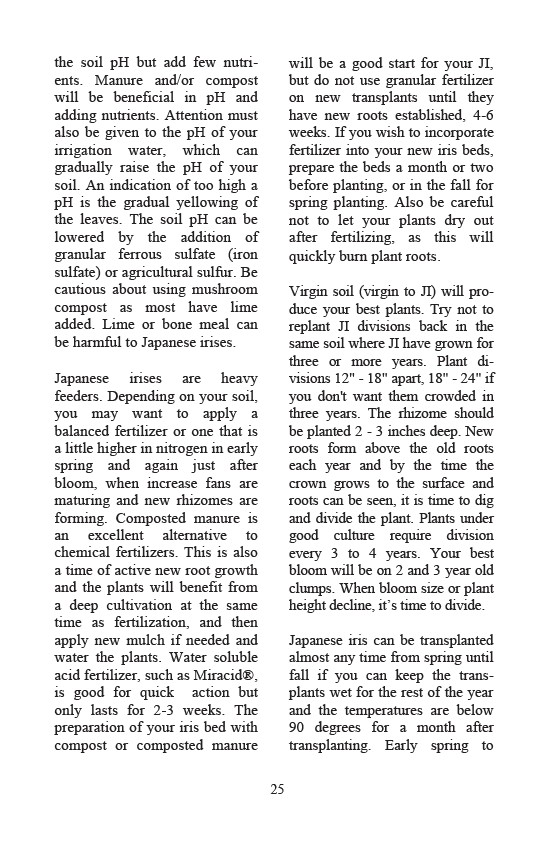
25
the soil pH but add few nutri-ents.
Manure and/or compost
will be beneficial in pH and
adding nutrients. Attention must
also be given to the pH of your
irrigation water, which can
gradually raise the pH of your
soil. An indication of too high a
pH is the gradual yellowing of
the leaves. The soil pH can be
lowered by the addition of
granular ferrous sulfate (iron
sulfate) or agricultural sulfur. Be
cautious about using mushroom
compost as most have lime
added. Lime or bone meal can
be harmful to Japanese irises.
Japanese irises are heavy
feeders. Depending on your soil,
you may want to apply a
balanced fertilizer or one that is
a little higher in nitrogen in early
spring and again just after
bloom, when increase fans are
maturing and new rhizomes are
forming. Composted manure is
an excellent alternative to
chemical fertilizers. This is also
a time of active new root growth
and the plants will benefit from
a deep cultivation at the same
time as fertilization, and then
apply new mulch if needed and
water the plants. Water soluble
acid fertilizer, such as Miracid®,
is good for quick action but
only lasts for 2-3 weeks. The
preparation of your iris bed with
compost or composted manure
will be a good start for your JI,
but do not use granular fertilizer
on new transplants until they
have new roots established, 4-6
weeks. If you wish to incorporate
fertilizer into your new iris beds,
prepare the beds a month or two
before planting, or in the fall for
spring planting. Also be careful
not to let your plants dry out
after fertilizing, as this will
quickly burn plant roots.
Virgin soil (virgin to JI) will pro-duce
your best plants. Try not to
replant JI divisions back in the
same soil where JI have grown for
three or more years. Plant di-visions
12" - 18" apart, 18" - 24" if
you don't want them crowded in
three years. The rhizome should
be planted 2 - 3 inches deep. New
roots form above the old roots
each year and by the time the
crown grows to the surface and
roots can be seen, it is time to dig
and divide the plant. Plants under
good culture require division
every 3 to 4 years. Your best
bloom will be on 2 and 3 year old
clumps. When bloom size or plant
height decline, it‟s time to divide.
Japanese iris can be transplanted
almost any time from spring until
fall if you can keep the trans-plants
wet for the rest of the year
and the temperatures are below
90 degrees for a month after
transplanting. Early spring to